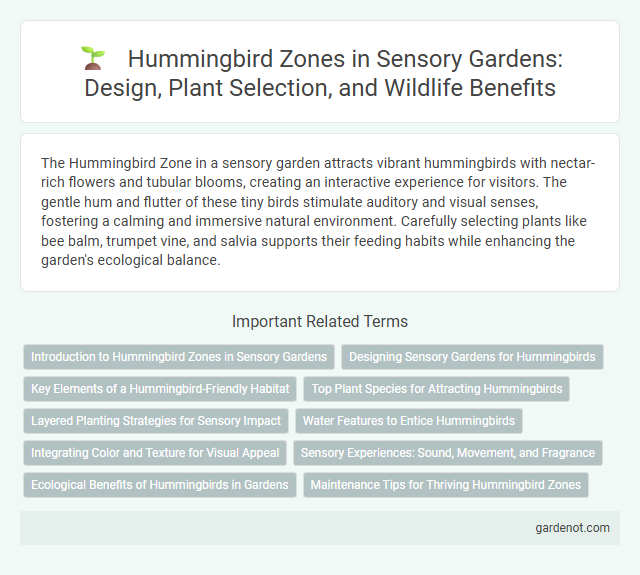The Hummingbird Zone in a sensory garden attracts vibrant hummingbirds with nectar-rich flowers and tubular blooms, creating an interactive experience for visitors. The gentle hum and flutter of these tiny birds stimulate auditory and visual senses, fostering a calming and immersive natural environment. Carefully selecting plants like bee balm, trumpet vine, and salvia supports their feeding habits while enhancing the garden's ecological balance.
Introduction to Hummingbird Zones in Sensory Gardens
Hummingbird zones in sensory gardens create vibrant habitats rich in nectar-producing plants like trumpet vine, salvia, and bee balm, attracting hummingbirds with their vivid colors and sweet scents. These zones emphasize tactile, visual, and olfactory stimulation by integrating textured foliage, diverse flower shapes, and aromatic blooms. Essential elements include feeders with sugar-water solutions and sheltered perching spots to enhance the interactive experience for visitors while supporting hummingbird conservation.
Designing Sensory Gardens for Hummingbirds
Designing sensory gardens for hummingbirds involves incorporating nectar-rich flowers like salvia, bee balm, and trumpet vine to attract these vibrant pollinators. Incorporate varied textures with soft foliage, reflective surfaces, and gentle water features to appeal to their keen senses. Position feeders and plants near sheltered, sunny spots to enhance hummingbird visitation and ensure year-round engagement.
Key Elements of a Hummingbird-Friendly Habitat
A hummingbird-friendly habitat includes nectar-rich flowers such as trumpet vine, bee balm, and salvia, which provide vital food sources during migration and breeding seasons. Incorporating perches like slender tree branches and shrubs supports their resting and territorial behavior, while a nearby water source such as a shallow birdbath encourages hydration and cooling. Avoiding pesticides and planting native species enhances insect availability, offering essential protein for hummingbird chicks.
Top Plant Species for Attracting Hummingbirds
The Hummingbird zone thrives with top plant species such as trumpet vine (Campsis radicans), bee balm (Monarda didyma), and salvias (Salvia spp.), which produce vibrant, tubular flowers rich in nectar. These plants provide essential food sources that attract hummingbirds by catering to their feeding preferences and support their migration and breeding cycles. Incorporating native species like columbine (Aquilegia canadensis) enhances habitat suitability and ensures sustainable hummingbird populations in sensory garden environments.
Layered Planting Strategies for Sensory Impact
Layered planting strategies in the Hummingbird Zone combine nectar-rich flowering shrubs, mid-height perennials, and groundcovers to create diverse sensory experiences that attract and sustain hummingbirds. Integrating vibrant colors, varying bloom times, and textured foliage stimulates visual appeal and tactile interaction for visitors. This approach enhances ecological value while providing a multi-sensory garden environment rich in scent, sound, and movement.
Water Features to Entice Hummingbirds
Water features in the Hummingbird zone, such as shallow birdbaths and gentle misters, create an inviting environment that attracts hummingbirds by providing essential hydration and cooling spots. The sound and movement of trickling water stimulate hummingbird activity, encouraging frequent visits and extended stay within the garden. Incorporating nectar-rich flowers near these water elements enhances the sensory appeal, fostering a vibrant ecosystem that supports hummingbird health and visibility.
Integrating Color and Texture for Visual Appeal
The Hummingbird Zone features vibrant blooms like red salvias and orange trumpet vines to attract hummingbirds while creating a visually rich environment. Diverse textures from velvety lamb's ear to spiky ornamental grasses add depth and tactile contrast, enhancing sensory engagement. Strategic plant placement maximizes color harmony and seasonal interest, ensuring continuous visual appeal throughout the year.
Sensory Experiences: Sound, Movement, and Fragrance
The Hummingbird Zone immerses visitors in a rich sensory experience through the gentle hum of buzzing wings and fluttering movements of hummingbirds, stimulating auditory and visual senses. Fragrant nectar-rich flowers amplify olfactory engagement, attracting these tiny birds and heightening the garden's aromatic appeal. This dynamic interaction fosters a multi-sensory environment that enhances emotional connection and mindfulness within the sensory garden.
Ecological Benefits of Hummingbirds in Gardens
Hummingbirds contribute significantly to garden ecology by pollinating native plants, enhancing biodiversity and supporting the reproduction of various flowering species. Their presence encourages a balanced ecosystem, aiding in pest control by feeding on small insects and maintaining healthy plant populations. Creating a dedicated Hummingbird zone with nectar-rich flowers also attracts these vital pollinators, promoting garden sustainability and ecological resilience.
Maintenance Tips for Thriving Hummingbird Zones
Regularly prune flowering plants such as trumpet vine and salvia to encourage continuous blooms that attract hummingbirds. Provide clean, fresh nectar feeders made with a 4:1 water-to-sugar ratio, and change the solution every 3-5 days to prevent mold and fermentation. Ensure the zone has ample native plants and minimal pesticide use to create a safe, sustainable habitat for hummingbirds.
Hummingbird zone Infographic

 gardenot.com
gardenot.com